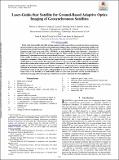| dc.contributor.author | Marlow, Weston | |
| dc.contributor.author | Carlton, Ashley | |
| dc.contributor.author | Hyosang, Yoon | |
| dc.contributor.author | Clark, James | |
| dc.contributor.author | Haughwout, Christian | |
| dc.contributor.author | Cahoy, Kerri | |
| dc.contributor.author | Males, Jared | |
| dc.contributor.author | Close, Laird | |
| dc.contributor.author | Morzinski, Katie | |
| dc.date.accessioned | 2017-08-15T18:51:59Z | |
| dc.date.available | 2017-08-15T18:51:59Z | |
| dc.date.issued | 2017-05 | |
| dc.identifier.issn | 00224650 | |
| dc.identifier.uri | http://hdl.handle.net/1721.1/110957 | |
| dc.description.abstract | In this study, the feasibility and utility of using a maneuverable nanosatellite laser guide star from a geostationary equatorial orbit have been assessed to enable ground-based, adaptive optics imaging of geosynchronous satellites with next-generation extremely large telescopes. The concept for a satellite guide star was first discussed in the literature by Greenaway and Clark in the early 1990s ("PHAROS: An Agile Satellite-Borne Laser Guidestar," Proceedings of SPIE, Vol. 2120, 1994, pp. 206-210), and expanded upon by Albert in 2012 ("Satellite-Mounted Light Sources as Photometric Calibration Standards for Ground-Based Telescopes," Astronomical Journal, Vol. 143, No. 1, 2012, p. 8). With a satellite-based laser as an adaptive optics guide star, the source laser does not need to scatter, and is well above atmospheric turbulence. When viewed from the ground through a turbulent atmosphere, the angular size of the satellite guide star is much smaller than a backscattered source. Advances in small-satellite technology and capability allowed the revisiting of the concept on a 6U CubeSat, measuring 10×20×30 cm. It is shown that a system that uses a satellite-based laser transmitter can be relatively low power (~1 W transmit power) and operated intermittently. Although the preliminary analysis indicates that a single satellite guide star cannot be used for observing multiple astronomical targets, it will only require a little propellant to relocate within the geosynchronous belt. Results of a design study on the feasibility of a small-satellite guide star have been presented, and the potential benefits to astronomical imaging and to the larger space situational awareness community have been highlighted. | en_US |
| dc.language.iso | en_US | en_US |
| dc.publisher | Journal of Spacecraft & Rockets | en_US |
| dc.title | Laser-Guide-Star Satellite for Ground-Based Adaptive Optics Imaging of Geosynchronous Satellites | en_US |
| dc.type | Article | en_US |
| dc.identifier.citation | Marlow, W. A., Carlton, A. K., Hyosang, Y., Clark, J. R., Haughwout, C. A., Cahoy, K. L., & ... Morzinski, K. M. (2017). Laser-Guide-Star Satellite for Ground-Based Adaptive Optics Imaging of Geosynchronous Satellites. Journal Of Spacecraft & Rockets, 54(3), 621-639. | en_US |
| dc.contributor.department | Space Telecommunications Astronomy and Radiation (STAR) Lab | |
| dc.contributor.department | Massachusetts Institute of Technology. Department of Aeronautics and Astronautics | |
